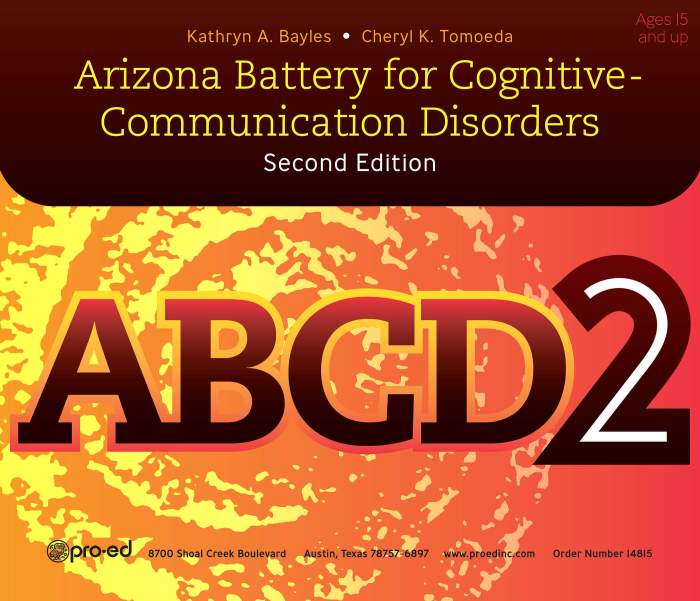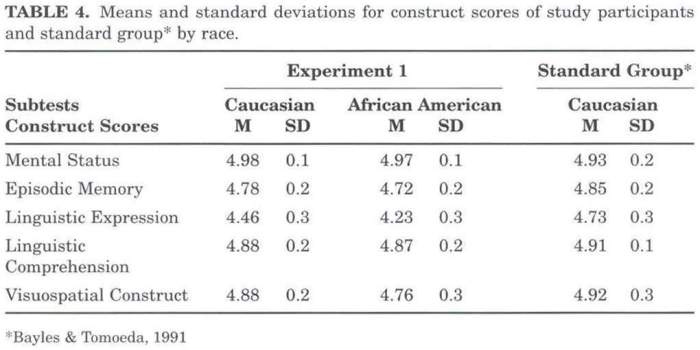The Arizona Battery of Communication Disorders of Dementia (ABCD) stands as a pivotal tool in the assessment and management of communication impairments in dementia. This comprehensive battery offers a nuanced understanding of the communication difficulties faced by individuals with dementia, providing invaluable insights for diagnosis, treatment planning, and ongoing support.
The ABCD’s subtests delve into various aspects of communication, including language comprehension, production, and discourse, capturing the multifaceted nature of dementia-related communication disorders. Its relevance extends beyond diagnosis, as it guides tailored interventions aimed at improving communication abilities and enhancing the quality of life for individuals with dementia and their caregivers.
Arizona Battery of Communication Disorders of Dementia (ABCD)

The Arizona Battery of Communication Disorders of Dementia (ABCD) is a comprehensive assessment tool designed to evaluate communication disorders associated with dementia. It is a standardized and reliable measure that provides valuable insights into the nature and severity of communication impairments in individuals with dementia.
Subtests Included in the ABCD
The ABCD consists of five subtests that assess different aspects of communication:
- Pragmatics: Evaluates the ability to use language in social situations, including turn-taking, topic maintenance, and inference.
- Semantics: Assesses the ability to understand and use words and concepts, including vocabulary, word retrieval, and semantic associations.
- Syntax: Examines the ability to produce and comprehend grammatical sentences, including sentence structure, verb tense, and agreement.
- Phonology: Evaluates the ability to produce and perceive speech sounds, including articulation, prosody, and phonemic awareness.
- Global Impression of Communication: Provides an overall rating of communication abilities, including fluency, clarity, and comprehension.
Relevance of ABCD Subtests to Dementia
The subtests of the ABCD are specifically designed to assess communication deficits that are commonly observed in dementia. For example, the Pragmatics subtest assesses difficulties with social communication, which is a hallmark of frontotemporal dementia. The Semantics subtest evaluates word retrieval and semantic memory impairments, which are characteristic of Alzheimer’s disease.
Dementia and Communication Impairments
Dementia is a progressive neurodegenerative disorder that affects memory, thinking, and behavior. Communication impairments are a common and significant feature of dementia, affecting up to 90% of individuals with the condition.
Types of Communication Difficulties
Communication difficulties in dementia can vary depending on the type and severity of the condition. Common impairments include:
- Language comprehension: Difficulty understanding spoken or written language.
- Language production: Problems with speaking, writing, or using gestures.
- Social communication: Challenges with initiating and maintaining conversations, understanding social cues, and using appropriate language in social situations.
Impact of Communication Impairments
Communication impairments can have a profound impact on individuals with dementia and their caregivers. They can lead to:
- Reduced social participation: Difficulty communicating can make it challenging to engage in social activities and maintain relationships.
- Increased caregiver burden: Communication problems can make it difficult for caregivers to provide support and care for their loved ones.
- Emotional distress: Communication difficulties can lead to frustration, anxiety, and depression for both individuals with dementia and their caregivers.
Research Findings
Research has consistently shown a strong relationship between communication disorders and dementia severity. Studies have found that individuals with more severe dementia experience greater communication impairments. Additionally, communication difficulties can be an early indicator of dementia, even before other cognitive symptoms become apparent.
Differential Diagnosis of Communication Disorders in Dementia
Differential diagnosis is essential in identifying communication disorders in dementia. It involves distinguishing ABCD from other communication disorders that may have similar symptoms, such as aphasia, autism spectrum disorder, or traumatic brain injury.
Key Characteristics of ABCD
Key characteristics that differentiate ABCD from other communication disorders include:
- Gradual onset: Communication difficulties develop gradually over time, rather than suddenly.
- Progressive course: Communication impairments worsen as dementia progresses.
- Cognitive deficits: Communication difficulties are accompanied by other cognitive deficits, such as memory loss, executive dysfunction, and visuospatial impairments.
Comparative Table
The following table compares ABCD with other common communication disorders in dementia:
| Characteristic | ABCD | Aphasia | Autism Spectrum Disorder | Traumatic Brain Injury |
|---|---|---|---|---|
| Onset | Gradual | Sudden or gradual | Early childhood | Sudden |
| Course | Progressive | Stable or improving | Persistent | Variable |
| Cognitive deficits | Present | Present | Present | May be present |
| Communication difficulties | Broad range of impairments | Language comprehension and production | Social communication and language | Variable, depending on injury severity |
Assessment and Interpretation of ABCD Results
The ABCD is administered by a trained speech-language pathologist (SLP). The SLP will ask the individual to perform a series of tasks, such as naming objects, answering questions, and following commands. The SLP will then score the individual’s performance based on a standardized scoring system.
Interpretation of Results
The ABCD results can be interpreted to provide information about the nature and severity of communication impairments. The results can also be used to:
- Diagnose dementia: ABCD results can be used to help diagnose dementia, particularly in cases where cognitive testing is inconclusive.
- Monitor disease progression: ABCD results can be used to track changes in communication abilities over time, which can help monitor disease progression.
- Plan treatment: ABCD results can be used to develop individualized treatment plans that target specific communication deficits.
Guidelines for Clinicians
- Consider the individual’s pre-morbid communication abilities: This can help to determine the extent of communication decline.
- Interpret results in the context of other cognitive and functional assessments: ABCD results should not be interpreted in isolation.
- Collaborate with other healthcare professionals: SLPs should work with neurologists, geriatricians, and other healthcare professionals to ensure a comprehensive evaluation and treatment plan.
Treatment Strategies for Communication Disorders in Dementia
The principles of communication intervention for individuals with dementia involve creating a supportive and communicative environment, using simplified language, and providing visual cues and prompts. Treatment approaches are tailored to the individual’s specific communication deficits, based on ABCD subtest results.
Specific Treatment Approaches, Arizona battery of communication disorders of dementia
- Pragmatics: Focus on improving turn-taking, topic maintenance, and inference skills through social communication training.
- Semantics: Target vocabulary enhancement, word retrieval strategies, and semantic memory exercises.
- Syntax: Provide sentence completion exercises, grammatical error correction, and sentence building activities.
- Phonology: Work on improving articulation, prosody, and phonemic awareness through speech therapy.
Communication Strategies for Daily Care
In addition to formal therapy, there are a number of communication strategies that can be implemented in daily care to support individuals with dementia:
- Use simple language: Avoid using jargon or complex sentences.
- Provide visual cues: Use gestures, pictures, or objects to help convey meaning.
- Give ample time to respond: Allow the individual plenty of time to process information and respond.
- Be patient and supportive: Communication difficulties can be frustrating. Be patient and provide support to the individual.
Role of the Speech-Language Pathologist in Dementia Care
SLPs play a vital role in the assessment and treatment of communication disorders in dementia. They work closely with other healthcare professionals to provide a comprehensive evaluation and treatment plan.
Assessment and Diagnosis
SLPs use the ABCD and other standardized assessments to evaluate communication abilities in individuals with dementia. They provide diagnostic information that can assist in the diagnosis of dementia and rule out other communication disorders.
Treatment and Intervention
SLPs develop and implement individualized treatment plans that target specific communication deficits. They provide therapy sessions and train caregivers in communication strategies to support the individual’s daily communication needs.
Collaboration and Support
SLPs collaborate with other healthcare professionals, such as neurologists, geriatricians, and nurses, to ensure a holistic approach to dementia care. They also provide ongoing support and education to individuals with dementia and their caregivers.
FAQ Summary
What is the Arizona Battery of Communication Disorders of Dementia (ABCD)?
The ABCD is a comprehensive assessment tool designed to evaluate communication disorders specifically associated with dementia.
How does the ABCD aid in differential diagnosis?
The ABCD helps differentiate dementia-related communication disorders from other communication impairments, ensuring accurate diagnosis and appropriate treatment.
What role do speech-language pathologists play in managing communication disorders in dementia?
Speech-language pathologists assess and treat communication disorders in dementia, collaborating with other healthcare professionals to provide holistic care.


